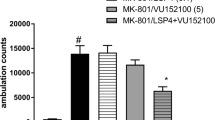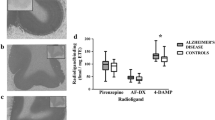Abstract
Sabcomeline [(R,-(Z)-(+)-α-(methoxyiamino)-1-azabicyclo[2.2.2.]octane-3-acetonitrile)] is a potent and functionally selective muscarinic M1 receptor partial agonist. However, little is known of the binding properties of sabcomeline underin vivo conditions. In this study, muscarinic receptor occupancy by sabcomeline in mouse brain regions and heart was estimated using [3H]quinuclidinyl benzilate (QNB) and [3H]N-methylpiperidyl benzilate (NMPB) as radioligands. In the cerebral cortex, hippocampus, and striatum, the estimated IC50 value of sabcomeline for [3H]NMPB binding was almost 0.2 mg/kg. Sabcomeline was not a selective ligand to M1 receptors as compared with biperidenin vivo. In the cerebral cortex, maximum receptor occupancy was observed about 1 hr after intravenous injection of sabcomeline (0.3 mg/kg), and the binding availability of mACh receptors had almost returned to the control level by 3–4 hr. These findings indicated that the binding kinetics of sabcomeline is rather rapid in mouse brain. Examination of dopamine D2 receptor binding revealed that sabcomeline affected the kinetics of both [3H]raclopride and [3H]N-methylspiperone (NMSP) binding in the striatum. It significantly decreased the k3 and k4 of [3H]raclopride binding resulting in an increase in binding potential (BP=k3/k4=Bmax/Kd) in sabcomeline-treated mice, and an approximately 15% decrease in k3 of [3H]NMSP binding was also observed. Although the mechanism is still unclear, sabcomeline altered dopamine D2 receptor affinity or availability by modulations via neural networks.
Similar content being viewed by others
References
Whitehouse PJ, Price DL, Struble RG, Clark AW, Coyle JT, Delon MR. Alzheimer’s disease and senile dementia: loss of neurons in the basal forebrain.Science 1982; 215: 1237–1239.
Coyle, JT, Price DL, DeLong MR. Alzheimer’s disease: a disorder of cortical cholinergic innervation.Science 1983; 219: 1184–1190.
Lehericy S, Hirsch EC, Cervera Pierot P, Hersh LB, Bakchine S, Piette F, et al. Heterogeneity and selectivity of the degeneration of cholinergic neurons in the basal forebrain of patients with Alzheimer’s disease.J Comp Neurol 1993; 330: 15–31.
Mash DC, Flynn DD, Potter LT. Loss of M2 muscarine receptors in the cerebral cortex in Alzheimer’s disease and experimental cholinergic denervation.Science 1985;228: 1115–1117.
Araujo DM, Lapchak PA, Robitaille Y, Gauthier S, Quirion R. Differential alteration of various cholinergic markers in cortical and subcortical regions of human brain in Alzheimer’s disease.J Neurochem 1988; 50: 1914–1923.
Probst A, Cortes R, Ulrich J, Palacios JM. Differential modification of muscarinic cholinergic receptors in the hippocampus of patients with Alzheimer’s disease: an autoradiographic study.Brain Res 1988; 450: 190–201.
London JM, Bromidge SM, Brown F, Clark MS, Hatcher JP, Hawkins J, et al. SB 202026: a novel muscarinic partial agonist with functional selectivity for M1 receptors.J Pharmacol Exp Ther 1997; 283: 1059–1068.
Hatcher JP, Loudon JM, Hagan JJ, Clark MS. Sabcomeline (SB-202026), a functionally selective M1 receptor partial agonist, reverses delay-induced deficits in the T-maze.Psychopharmacology 1998; 138: 275–282.
Hodges H, Peters S, Gray JA, Hunter AJ. Counteractive effects of a partial (sabcomeline) and a full (RS86) muscarinic receptor agonist on deficits in radial maze performance induced by S-AMPA lesions of the basal forebrain and medial septal area.Behav Brain Res 1999; 99: 81–92.
Harries MH, Samson NA, Cilia J, Hunter AJ. The profile of sabcomeline (SB-202026), a functionally selective M1 receptor partial agonist, in the marmoset.Br J Pharmacol 1998; 124: 409–415.
Shinotoh H, Asahina M, Inoue O, Suhara T, Hirayama K, Tateno Y. Effects of trihexyphenidyl andl-dopa on brain muscarinic cholinergic receptor binding measured by positron emission tomography.J Neural Transm Park Dis Dement Sect 1994; 7: 35–46.
Bolden, C, Cusack B, Richelson E. Antagonism by antimuscarinic and neuroleptic compounds at the five cloned human muscarinic cholinergic receptors expressed in Chinese hamster ovary cells.J Pharmacol Exp Ther 1992; 260: 576–580.
Hosoi R, Kobayashi K, Watanabe Y, Inoue O. Evaluation ofin vivo binding properties of3H-NMPB and3H-QNB in mouse brain.J Neural Transm 1999; 106: 583–592.
Dewey, SL, Smith GS, Logan J, Brodie JD, Simkowitz P, MacGregor RR, et al. Effects of central cholinergic blockade on striatal dopamine release measured with positron emission tomography in normal human subjects.Proc Natl Acad Sci USA 1993; 90: 11816–11820
Kobayashi K, Inoue O. An increase in thein vivo binding of [3H]SCH 23390 induced by MK-801 in the mouse striatum.Neuropharmacology 1993; 32: 341–348.
Patlak, CS, Blasberg RG. Graphical evaluation of blood-tobrain transfer constants from multiple-time uptake data. Generalizations.J Cereb Blood Flow Metab 1985; 5: 584–590.
Wood MD, Murkitt KL, Ho M, Watson JM, Brown F, Hunter AJ, et al. Functional comparison of muscarinic partial agonists at muscarinic receptor subtypes hM1, hM2, hM3, hM4 and hM5 using microphysiometry.Br J Pharmacol 1999; 126: 1620–1624.
Levey AI. Immunological localization of m1–m5 muscarinic acetylcholine receptors in peripheral tissues and brain.Life Sci 1993; 52: 441–448.
Wei J, Walton EA, Milici A, Buccafusco JJ. m1–m5 muscarinic receptor distribution in rat CNS by RT-PCR and HPLC.J Neurochem 1994; 63: 815–821.
Tice MA, Hashemi T, Taylor LA, McQuade RD. Distribution of muscarinic receptor subtypes in rat brain from postnatal to old age.Brain Res Dev Brain Res 1996; 92: 70–76.
Stengel PW, Cohen ML. Low-affinity M(2) receptor binding state mediates mouse atrial bradycardia: comparative effects of carbamylcholine and the M(1) receptor agonists sabcomeline and xanomeline.J Pharmacol Exp Ther 2001; 296: 818–824.
Dewey SL, Smith GS, Logan J, Alexoff D, Ding YS, King P, et al. Serotonergic modulation of striatal dopamine measured with positron emission tomography (PET) andin vivo microdialysis.J Neurosci 1995; 15: 821–829.
Smith GS, Dewey SL, Brodie JD, Logan J, Vitkun SA, Simkowitz P, et al. Serotonergic modulation of dopamine measured with [11C]raclopride and PET in normal human subjects.Am J Psychiatry 1997; 154: 490–496.
Dewey SL, Smith GS, Logan J, Brodie JD, Yu DW, Ferrieri RA, et al. GABAergic inhibition of endogenous dopamine release measuredin vivo with11C-raclopride and positron emission tomography.J Neurosci 1992; 12: 3773–3780.
Smith GS, Schloesser R, Brodie JD, Dewey SL, Logan J, Vitkun SA. et al. Glutamate modulation of dopamine measuredin vivo with positron emission tomography (PET) and11C-raclopride in normal human subjects.Neuropsychopharmacology 1998; 18: 18–25.
Dewey SL, Smith GS, Logan J, Brodie JD, Fowler JS, Wolf AP. Striatal binding of the PET ligand11C-raclopride is altered by drugs that modify synaptic dopamine levels.Synapse 1993; 13: 350–356.
Endres CJ, Kolachana BS, Saunders RC, Su T, Weinberger D, Breier A. et al. Kinetic modeling of [11C]raclopride: combined PET-microdialysis studies.J Cereb Blood Flow Metab 1997; 17: 932–942.
Tsukada H, Nishiyama S, Kakiuchi T, Ohba H, Sato K, Harada N. Is synaptic dopamine concentration the exclusive factor which alters thein vivo binding of [11C]raclopride?: PET studies combined with microdialysis in conscious monkeys.Brain Res 1999; 841: 160–169.
Opacka Juffry J, Ahier RG, Cremer JE. Nomifensineinduced increase in extracellular striatal dopamine is enhanced by isoflurane anaesthesia.Synapse 1991; 7: 169–171.
Kobayashi K, Inoue O, Watanabe Y, Onoe H, Langstrom B. Difference in response of D2 receptor binding between11C-N-methylspiperone and11C-raclopride against anesthetics in rhesus monkey brain.J Neural Transm Gen Sect 1995; 100: 147–151.
Tsukada H, Harada N, Nishiyama S, Ohba H, Kakiuchi T. Cholinergic neuronal modulation alters dopamine D2 receptor availabilityin vivo by regulating receptor affinity induced by facilitated synaptic dopamine turnover: positron emission tomography studies with microdialysis in the conscious monkey brain.J Neurosci 2000; 20: 7067–7073.
Kobayashi K, Gee A, Hosoi R, Inoue O. Changes in apparentin vivo binding of [3H]raclopride and [3H]N-methylspiperone induced by oxotremorine.J Neural Transm 1998; 105: 1193–1197.
Seeman P, Guan HC, Niznik HB. Endogenous dopamine lowers the dopamine D2 receptor density as measured by [3H]raclopride: implications for positron emission tomography of the human brain.Synapse 1989; 3: 96–97.
Ross SB, Jackson DM. Kinetic properties of the accumulation of3H-raclopride in the mouse brainin vivo.Naunyn Schmiedebergs Arch Pharmacol 1989; 340: 6–12.
Hall H, Wedel I, Halldin C, Kopp J, Farde L. Comparison of thein vitro receptor binding properties ofN-[3H]methylspiperone and [3H]raclopride to rat and human brain membranes.J Neurochem 1990; 55: 2048–2057.
Young LT, Wong DF, Goldman S, Minkin E, Chen C, Matsumura K, et al. Effects of endogenous dopamine on kinetics of [3H]N-methylspiperone and [3H]raclopride binding in the rat brain.Synapse 1991; 9: 188–194.
Author information
Authors and Affiliations
Corresponding author
Rights and permissions
About this article
Cite this article
Hosoi, R., Kobayashi, K., Ishida, J. et al. Effect of sabcomeline on muscarinic and dopamine receptor binding in intact mouse brain. Ann Nucl Med 17, 123–130 (2003). https://doi.org/10.1007/BF02988450
Received:
Accepted:
Issue Date:
DOI: https://doi.org/10.1007/BF02988450




